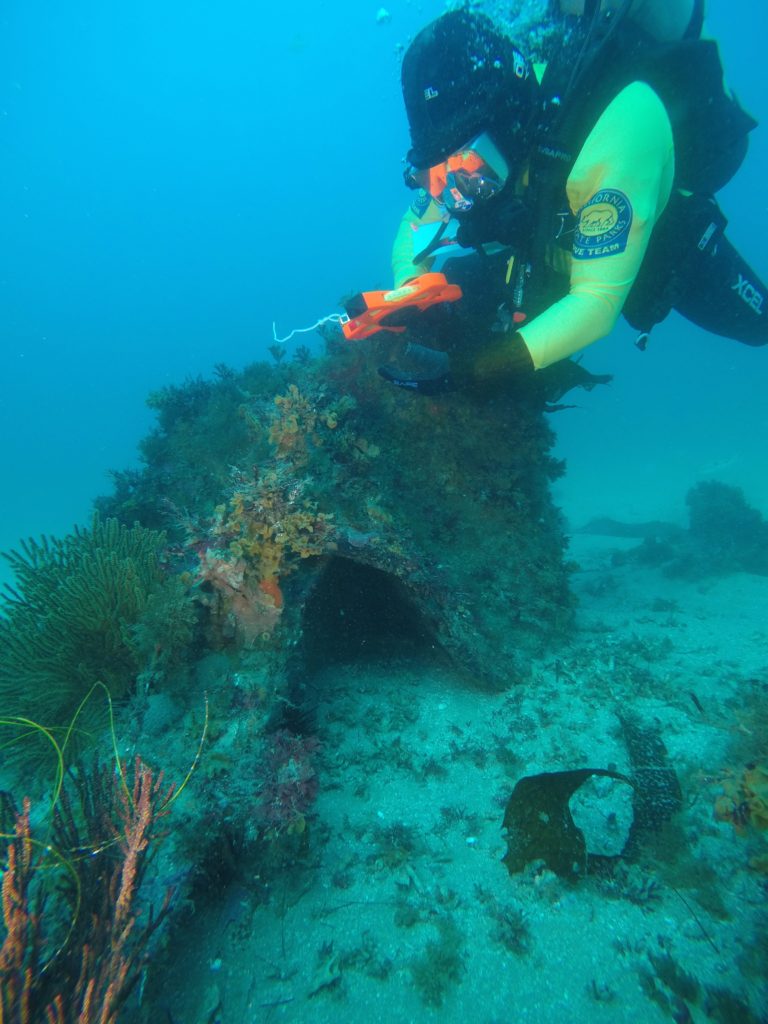Submerged treasures at Crystal Cove

On a beautiful autumn day in early November of 2018, the California State Parks dive team convened on a boat offshore of Crystal Cove State Park, ready to take a plunge. The visibility was excellent that day, and would make for a fascinating survey. The mission? To conduct a condition assessment for a very precious cultural resource at the bottom of the ocean. Measurements were drawn, notes were made, and photographs were taken at the site. To the average diver, what was being measured appeared to be none other than a few large unusual rocky objects, teaming with young sea life. But to the seasoned State Parks staff conducting the survey, this site represented one of the most fascinating cultural treasures hidden beneath the water at Crystal Cove State Park: a downed 1945 Vaught F4-U Corsair.
The Corsair was considered one of the best combat planes of World War 2, and was a huge asset in the winning of the Pacific War. It was feared by the Japanese, who nicknamed it “Whistling Death.” It proved so effective that it remained in development after the war, and would see usage in Korea up until the introduction of jet aircraft. Like the Corsair’s own transition from one war to another, 1949 marked a very important transition in Orange County itself. While Crystal Cove remained the isolated sleepy beach community and occasional movie set, the rest of the county was going through a radical change. The end of the war saw a boom in development and population, with new families looking for places to live and thrive. The orange groves and undeveloped fields would soon be turned into sprawling residential tracts and freeways.
All of this would have been seen from the cockpit of Lieutenant William Anderson’s F4-U Corsair on the morning of July 5 1949 as he made his way down the coast of Orange County. The F4-U did not see action in the war, it was a newer version released in the mid 40’s. Lieutenant Anderson was on his way back to Los Alamitos Air Station after a routine training flight to San Diego, when he began having engine trouble. As he was just outside of Laguna Beach, Anderson began to realize that his engine was failing, and he would not be able to make it back to Los Alamitos. He would have to ditch. He flew low, eased down, made a perfect ditching just parallel with Crystal Cove, and hit the water flat at 90mph. The plane immediately began to sink, and Anderson was just barely able to make it out when a local fishing boat happened to be passing by and rescued him. The Corsair would sink beneath the ocean, resting in its marine grave and forgotten.
It would be nearly a decade before the first of several rediscoveries of the Corsair. Military personnel in 1961 managed to identify the plane by accident while diving in the area, leading to the Navy returning to the site to remove the engine (The Navy still possesses ownership of the Corsair). It would stay a well-kept secret among local divers for the years that followed, leading to a few features in Skin Diver magazine. But as the decades wore on, the unpredictable underwater world began to take its toll on the plane. Storms tossed it about, anchors tore it apart, and sand and sea life began to slowly hide it from existence. Although the site is unrecognizable today, it has fortunately become a healthy and diverse habitat for a large community of young sea life, including different varieties of algae, soft coral, kelp, fish, sea urchins. In 1979, Crystal Cove became a new state park, and as the Corsair resided within the Crystal Cove Marine Protection Area, it has been continuously managed and preserved as a treasured cultural resource from a very unique and special time in Crystal Cove’s history, just like any other natural resource above or below the water.

As much as we know about this story, we know there is still so much more to share about the special history of Crystal Cove. If you have any information related to this story that you would like to share, or about other stories related to the history of Crystal Cove, please let us know! You can reach us at david@crystalcove.org
